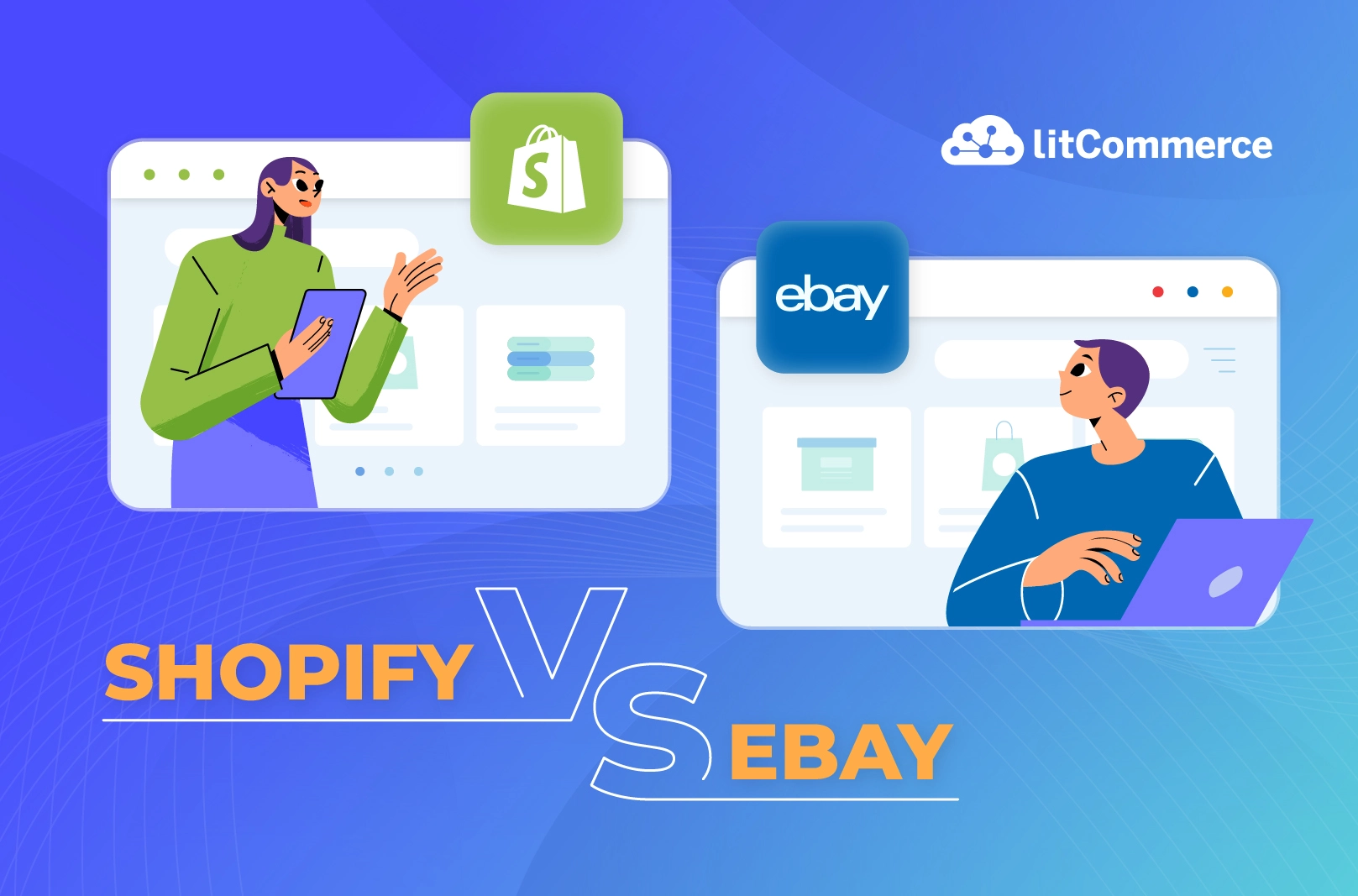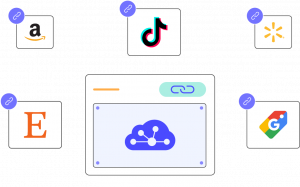Shopify vs eBay – The pain of choosing the right sales channel for your online venture is just real! Trust us, we feel it too. We’ve been there, made our evaluation, and here’s what we think:
- If you want to build your own website with strong brand recognition, complete control, and probably no on-site competition, Shopify is a better choice than eBay.
- Otherwise, for those who just want to focus on the selling part and are not ready to take all the hassle of maintaining a website, eBay is your go-to sales channel.
So Shopify or eBay is more ideal for you? In any case, we know the choice is tough. But we believe you’ll make the right decision once you’ve learned their differences in all aspects. Keep scrolling through because LitCommerce is about to reveal every detail.
Let’s get our discussion started!
Shopify vs eBay Comparison: The Very Basics
First things first—we’re walking you through the most basic parts of Shopify and eBay and their biggest differences. If you are a new online merchant, stay focused on this part!
About Shopify
Shopify is an eCommerce platform, keep that in mind. Developed as a cloud-based shopping cart, Shopify offers a hosted and standalone solution whose sole purpose is to start and manage an online store. Online merchants will have their stores up and running quickly while knowing next to nothing about technical skills.
About eBay
eBay is one of the top marketplaces for selling products online. It accommodates thousands of different B2B and C2C vendors to put almost anything new and used on the market.
More about this marketplace: eBay sellers can specify a starting price for their items and start the bidding processes between buyers thanks to auction-style listings. When the listing ends, whoever with the highest bid wins the right to buy the items.
You might want to read also: How to Sell on eBay for Beginners (2025 Updated)
Pros and cons of selling on Shopify vs eBay
Is Shopify like eBay? They are certainly not the same.
One is an eCommerce platform that powers your store, letting you come to your full roles, while the other is a dynamic marketplace, which comes with fierce competition.
Continuing our discussion about selling on Shopify vs eBay, here are the pros and cons of each.
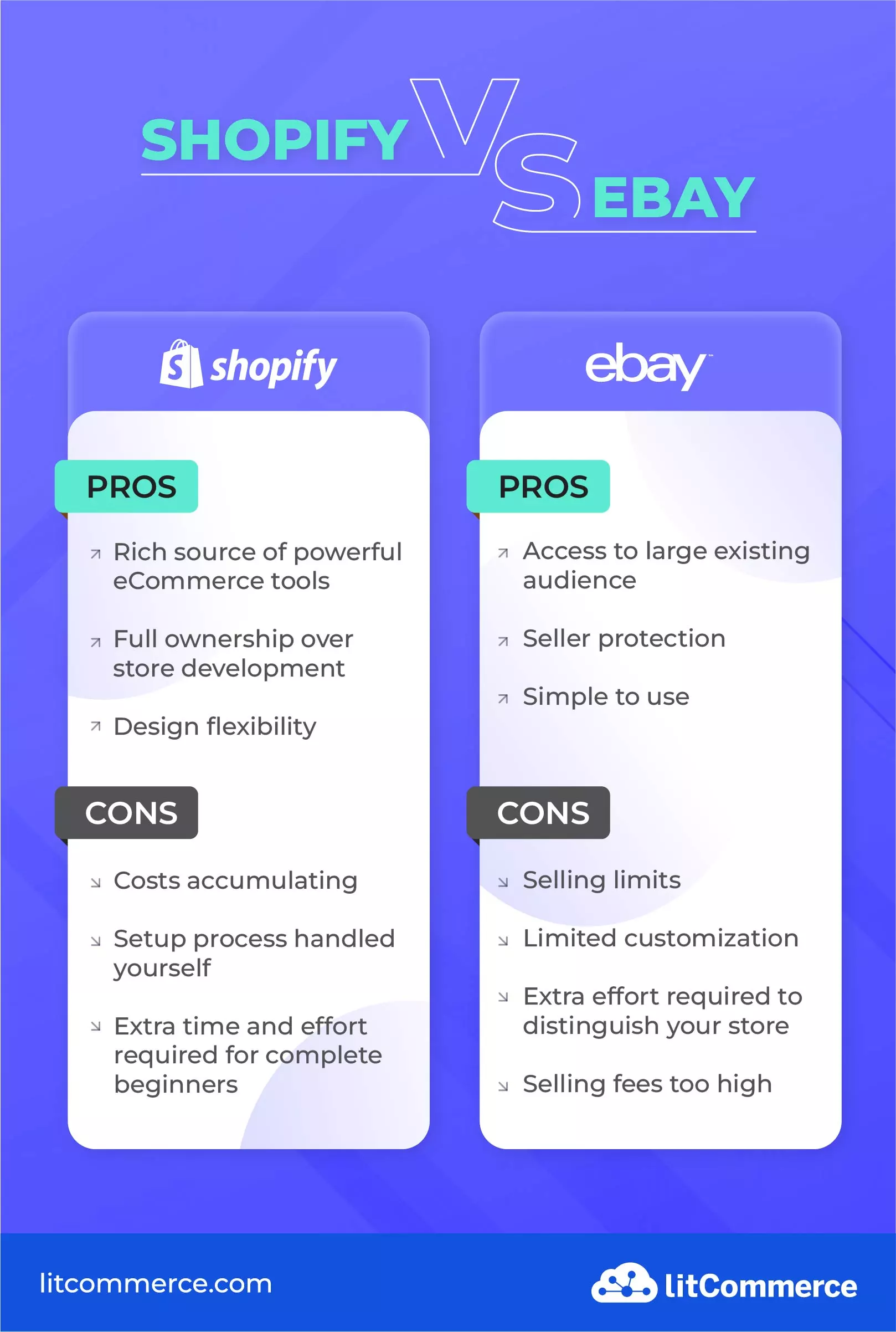
Shopify’s pros and cons

Strengths
When it comes to Shopify, there are several benefits you might get.
- Rich source of eCommerce tools: Shopify equips its users with an extensive app collection, where powerful eCommerce tools and features can readily cater to every business need. With over 8,000 apps on its app store, Shopify certainly provides sellers with everything they need to build a functional online store.
- Full ownership over store development: Because you are the creator of your store, everything is under your control. With the support of the Shopify-powered template language – Liquid, users can create and edit specific product content and systems, namely product titles, price, tags, and filters, logically at their convenience.
- Design flexibility: Shopify has a wide collection of themes and templates for users to put on a visually attractive store display with high creative freedom. You can also use Shopify theme development services to improve your site’s visibility and functionality.
Weaknesses
- Costs accumulating: Since you take full charge of the website development, you will have to factor in all aspects to get your store up and running, which means you have to pay a considerable amount for the utmost scalability. Not to mention, you aren’t only paying for Shopify plans but also third-party apps’ charges if you ever use them.
- Setup process handled yourself: Mostly in charge of a whole standalone website, you have to make all arrangements on your own, from website development, themes, and design to marketing and security.
- Extra time and effort required for complete beginners: In exchange for the development flexibility, you will have a large amount of knowledge to learn to properly operate your store, which will be a real burden to fresh users. And remember the part where we mentioned Liquid? Keep in mind that Liquid isn’t for non-coders at all. You’ll have to spend more time and effort if you want a higher level of store customization on Shopify using Liquid.
eBay’s pros and cons
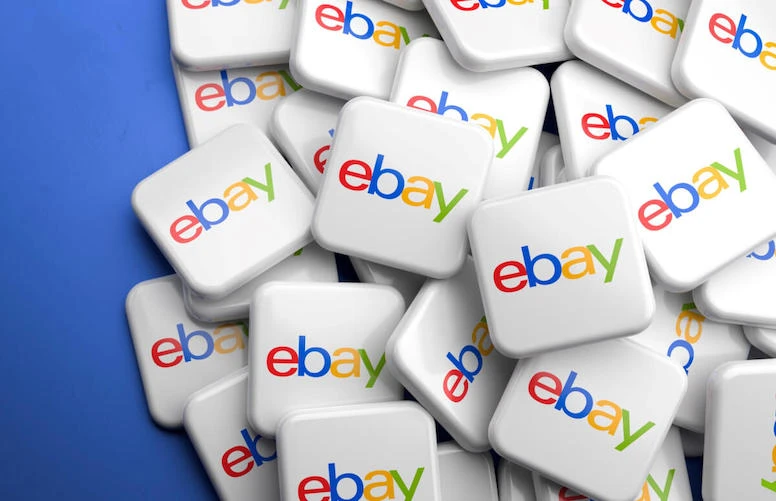
Strengths
Merchants can get several benefits from the eBay store when selling on this platform:
- Access to a large existing audience: eBay uses the leading online marketplace reputation to its advantage by constantly connecting sellers with millions of global buyers. In fact, in Q1 2024, eBay had up to 132 million active shoppers.
- Seller protection: As a seller-oriented online marketplace, eBay has its own set of policies to protect sellers from any unethical purchase practices and out-of-control events. In specific, eBay will remove any unfavorable feedback and defects if they are proven to be caused by external factors and the sellers are not to blame.
- Ease of selling: eBay already provides existing frameworks for users to conveniently follow their guidance and create a store of their own. Also, setting up a store on eBay only takes a few minutes.
Weaknesses
- Selling fees too high: Because they have to host millions of shoppers and sellers, eBay frequently charges the latter very high category referral fees, around 13 to 15%. Some categories also have specific charges based on sales volume. And more about eBay’s rising fees? You might have to pay for listing upgrades, international selling fees, and more.
- Selling limits: eBay sets the rules on how you sell periodically, such as the listings and the categories. The rules go straight at new sellers. However, the limits can be adjusted depending on your revenue and the feedback you have received from your customers. eBay will review your account every month.
- Limited customization: eBay fails to provide as much development flexibility, leaving online sellers no choice but to rely on their default features and limiting the prospects of scalability.
- The extra effort required to distinguish your store: Considering the little room for customization, hard work is significantly essential. And there are thousands of other sellers listing the same items as yours. If you are not manufacturing your own items, you’ll be struggling to gain any brand recognition on eBay.
You may also like: eBay vs Facebook Marketplace: Find Your Best Sales Channel (2025 Updated).
After the pros and cons, should you sell on Shopify or eBay?
Walking through the pros and cons of the Shopify vs eBay comparison, we see some huge differences.
- Shopify provides you with everything to build and functionalize your store. You will also take complete control. However, setting up will take some time, even when you use the drag-and-drop tools by Shopify. As an added point, from our experts’ perspective, having full control over your business can be beneficial in the long run since you don’t have to follow the rules of a marketplace. Yet, running your store efficiently and making sales are some real obstacles.
- eBay has the advantage of massive traffic, seller protection, and ease of selling over Shopify. But you have less control and more on-site competition. Not to mention, eBay has some strict selling limits and business performance criteria. Just make sure you can catch up with this marketplace.
Do they have something in common? We think they do. Both have some complex fee structures. We also assume that for someone with an extra low initial budget, selling on these sales channels can be a bit risky.
Another thing we notice is that both Shopify and eBay require you to spend a lot of time and effort. One is to draw traffic, while the other is to stand out from the crowd. Nonetheless, all your time and effort spent on Shopify and eBay is to eventually make sales.
Can I Leverage The Power of Shopify and eBay?
Yes! You can smoothly run your multi-channel business by listing your Shopify products on eBay and managing them from ONE central spot with LitCommerce!
Shopify vs eBay: Detailed Comparison
Now is definitely a good time for the ins and outs of Shopify and eBay to see which one will sit well with you. In this section, we’re breaking down the Shopify eBay comparison into 7 parts, including:
- Seller fees
- Product types
- Ecommerce tools and features
- Order fulfillment and shipping
- Marketing tools and features
- Themes and designs
- Seller support and community
Let’s dive deep into each part and see if eBay or Shopify matches you better!
Shopify is among the top eBay alternatives for sellers. But what about other potential ones? Read our article and find out soon. It’s already live on LitCommerce Retail Blog!
Seller fees
Do Shopify and eBay have different pricing tiers? Certainly, YES. According to our experience and observations with both, they definitely have complex structures, and they can be expensive for sellers.
Keep scrolling our Shopify vs eBay comparison and find out how different their pricing tiers are.
Shopify pricing
Basically, Shopify is a subscription-based eCommerce platform solution and offers different pricing plans so users can pay the most suitable price for their business size.
Here are the pricing tiers Shopify announces on its site:
- Basic: $39 per month
- Shopify: $105 per month
- Advanced: $399 per month
According to Shopify, merchants will pay from $39 or more per month for subscription, depending on your business demand, model, and scale. As far as we know, your monthly subscription on Shopify will be 25% lower if billed annually. This means:
- Basic will be $29 a month
- Shopify will be $79 a month
- Advanced will be $299 a month
There is one more tier, which is the Plus plan. It is a customized one for extra complex businesses. Pricing for such plans will also be customized, according to your demands. If your business needs more features from Shopify, seller fees may rise significantly.
Aside from the subscription fees, sellers need to pay for the following necessities to operate and optimize an effective Shopify store:
- Transaction & Payment Processing fees: If you use Shopify payment – an in-house payment solution from Shopify, they are complementary. Other payment gateways will charge you extra, around 0.5% to 2%, depending on your pricing plans. Such fees can add up, based on what provider or your products, etc. Here are the details:
- Card rates start at 2% for third-party payment providers (Basic tier)
- Card rates start at 1% for third-party payment providers (Shopify tier)
- Card rates start at 0.5% for third-party payment providers (Advanced tier)
- Other plugins/extensions:
- Domain name: Starting at $11/year.
- Themes and designs: From $0 to $350.
- Add-ons and integrations: From $20 to $70 (some are even more than $350).
For an in-depth comparison of feature fees across all pricing plans, please feel free to refer to this detailed Shopify Pricing guide.
eBay selling fees
Conversely, eBay charges sellers different layers of pricing, but there are two major fee types:
- Listing fees: $0.35/listing after you’ve run out of 250 free listings.
- Final value fees: From 13.25% to 15% based on your product categories. (Note that your final value fees will come with $0.40 as a per-order fee)
According to eBay seller fees, you will have to pay other 3 main types of fees when using eBay’s services:
- Store subscription: From $7.95 to $349.95 (Does not apply to individual sellers).
- Fee for real estate listings: If you list real estate on eBay (in auction and fixed-price models), you’ll pay from $35 to $300.
- Advertising fees: You have to apply this additional fee if you advertise items within the platform and they are sold.
- Dispute fees: If you are found liable for a dispute claim, you are prone to this fee, which is about $20.
- Listing upgrades: This fee goes from $0.35 to $5 for different categories.
- Additional final value fees: eBay charges you extra if you don’t adapt to its business performance criteria or buy and sell off eBay.
- International fees: eBay charges an extra 1.65% of your total sales. However, this applies when you sell to regions outside of the US. If you are a seller from outside of the US, come and check eBay’s fee policies here.
- Seller currency conversion fees: eBay maintains a 3% charge for currency conversion (other currencies than USD).
At the same time, you should keep in mind that you can’t receive the return fees if your items are unable to sell.
The verdict:
When comparing Shopify vs eBay fees, Shopify offers a more simplified pricing structure than eBay. However, it is hard to tell that Shopify or eBay is cheaper to start with. But if we have to choose one, we would go with eBay as an individual seller, and Shopify as a small business.
Products types
In the comparison of Shopify vs eBay, choosing the most suitable and profitable products to sell is super necessary. Correspondingly, sellers should look for the product type, which is allowed to display on these selling channels.
Shopify’s product types
Shopify is quite generous with the product types they allow to sell on their platform. Despite the tough competition, you can refer to the top trending products to sell on Shopify and make the best profits from them, particularly:
- Vitamins and supplements
- Skincare and makeup products
- Apparel
- Beddings
- Perfume and cologne
- Cookware and drinkware
- Mobile accessories
- Motor vehicle parts
- Underwear
- Posters and artwork
- Nailcare products
- Bicycles
However, you must make sure that your products and services are consonant with Shopify’s Acceptable Use Policy (AUP) in that you steer clear of certain prohibited items. They can range across this list:
- Firearms;
- Child exploitation;
- Intellectual property;
- Terrorist organizations;
- Self-harm;
- Others.
eBay’s product types
Does eBay have some trending categories? Yes, they do. Feel free to check out the compilation of what sells best on eBay:
- Apparel and accessories
- Health and beauty
- Home and garden
- Pet supplies
- Jewelry and watches
But do you know what also sells incredibly well on eBay? Secondhand luxurious items. As a matter of fact, 57% of US shoppers buy such items from eBay, and eBay is one of the most popular sites when it comes to secondhand goods.
On the contrary, eBay is pretty strict about the products they allow store owners to sell there. Above all, their responsibility is to, as they always highlight, ensure the safety of their community and increase customer experience.
Apart from the best sellers, you need to bear in mind eBay’s selling limits and the list of prohibited and restricted items policies, for example:
- Mature audiences only (prohibited);
- Drugs and drug paraphernalia (prohibited);
- Firearms, weapons, and knives (prohibited);
- Alcohol (restricted);
- Animal products (restricted);
- Charity listings (restricted).
As a result, this may call for a great deal of patience and hard work to comply with their selling rules, or else there will be violations, and you will be under the selling restrictions.
If it’s any consolation to you, eBay will increase your selling limits when you are deemed to meet enough buyer demand.
The verdict:
Shopify and eBay almost have the same diversity when it comes to products. However, Shopify will fit brands and new items so much more, and eBay is better for secondhand goods. Another thing is that eBay may set more limits on the product types sellers can put on display. But this will help ensure sellers confidently run their stores under eBay’s protection.
Ecommerce tools and features
Both Shopify and eBay have their own eCommerce selling tools to help sellers streamline sales operations and manage data effortlessly. Let’s take a deeper look at each platform to find out what both Shopify and eBay provide for their sellers.
Shopify eCommerce tools and features
Shopify itself comes with an impressive number of inbuilt eCommerce features, some of which are:
- Inventory management: It is possible to add products on the back-end interface or import CSV files with intuitive listing templates. Sellers can keep track of the inventory cycle on sale, from controlling the inventory amount via SKUs to delivering the products properly. Besides, Shopify provides some of the best inventory management apps.
- POS system: It perfects the simple process of making transactions for customers in a user-friendly way to make sure that sales can be generated from anywhere, both online and in person.
- CRM system: The system makes sure that users are in capable hands thanks to task automation, including but not limited to marketing channel and customer service process, and the analytics strengths for data-driven decisions.
- SSL certificates: This functionality, present in every Shopify pricing plan, encrypts all sensitive data, particularly credit details, for the security of transactions, thus enhancing the credibility of potential customers in your brand.
Notably, you can look for any tools, ranging from products, inventory, and payments, to shipping, to integrate with your store and expand the functionality with the Shopify App Store. There are several free Shopify apps to meet your business needs, such as review or social media add-ons.
eBay eCommerce tools and features
Because of eBay’s competitive marketplace nature, sellers need to take every opportunity associated with eCommerce tools and features to differentiate themselves and optimize their stores. Correspondingly, there is a large selection of professional extensions that eBay offers to achieve that objective:
- Seller Hub: Provide business and management optimization
- Selling manager tool and Selling templates: Instruct sellers to manage, create, and monitor listings. You can list multiple items on eBay or utilize eBay listing tools to save countless hours and effort.
- Promotions manager: Develop promotion campaigns as part of Marketing activities for the target customers.
- Sales reports: Track and analyze business performance to understand the main sales drivers and produce sales generation techniques.
- eBay apps: Equip stores with state-of-the-art eBay tools to boost store performance.

Furthermore, consider those suitable for your location and your product characteristics.
The verdict:
In regards to eCommerce tools and features, it’s a tie between eBay and Shopify because they have their own repertoire of extensions for their intended users to grow their business.
Order fulfillment and shipping
Order fulfillment
There are 2 main order fulfillment methods in Shopify and eBay for store owners to choose from.
The self-fulfillment method is reasonable if you:
- Have just opened your store;
- Plan to operate it on a small scale;
- Require an economical option;
- Plan to use personalized packaging;
- Sell custom products.
You are able to look for third-party fulfillment service providers who will handle the storage, packaging, and shipping for you. They are mostly Shopify and eBay-integrated apps that connect with your admin and update your order progress in line with the fulfillment. This option suits you best if:
- You seek outside help for the post-payment tasks;
- Your warehousing capabilities are past the point where you can handle the job manually.
Although this method will save you time compared to manual fulfillment, it raises costs for large-scale businesses as you will be charged for the corresponding services.
Shipping
Product delivery varies among 3 main methods: local pickup, local delivery, and shipping, in that it depends on the availability and characteristics of your products. Shopify and eBay will connect your accounts with different shipping carriers so that they will do the job for you.
While local pickup and local delivery alike require direct interactions from both parties, Shopify and eBay have acquired a network of integrated shipping carriers for the purpose of product shipping. Given the buyers’ registered shipping address, those shipping providers will transport and deliver the items.
Whether domestic or international, export or import, buyers can access eBay shipping solutions and Shopify shipping services from a few prime examples, such as DHL eCommerce, FedEx, USPS, and UPS. Therefore, it’s best to learn how to ship on eBay and Shopify properly to fully control shipping fees.
The breaking news
However, Shopify owns up to eBay over dropshipping in the sense that the former proudly stands high in the list of top 10 B2B marketplaces for dropshipping. Basically, you can save plenty of money – $31/month – and time – 30 to 40 minutes – to set up and start the most basic dropshipping store with Shopify.
Indeed, the availability of over 100 Shopify dropshipping apps, a renowned name being Oberlo, is also convincing that online store owners are likely to make a profit from this niche.
The verdict:
Although Shopify and eBay share a majority of similarities in order fulfillment and shipping options, Shopify still has a slight advantage over eBay in the dropshipping power.
Marketing efforts
This is a crucial aspect for any seller asking, “Is Shopify better than eBay?”. We think when it comes to marketing, Shopify stands a huge advantage over eBay.
To prove that statement, let us walk you through these major parts: SEO, Analytics, and Social Media integration.
SEO
- SEO on Shopify
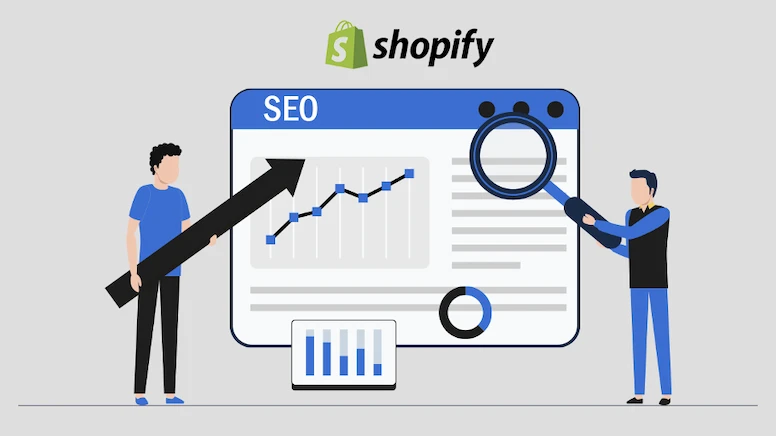
Doing SEO on Shopify, you may get access to:
- Greater control over SEO elements: Directly edit meta titles, descriptions, and URLs for your products and store.
- Customization: Build a unique and informative website that can be optimized for search through content marketing strategies like blog posts and landing pages.
- App integrations: Shopify offers a vast app store with SEO tools (Tapita, SEOAnt, etc.) that can help with keyword research, competitor analysis, and on-page optimization.
Note that: SEO on Shopify works on general search engines, and you probably have more control over SEO with more support. But building a store on Shopify also means you have no massive built-in audience. So, driving traffic to your store can be a real challenge.
- SEO on eBay
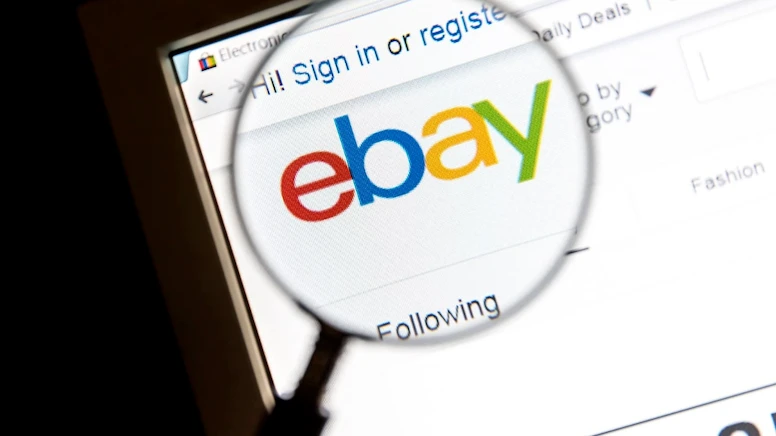
Doing SEO on eBay is a bit different from Shopify since it focuses on marketplace rankings. More about eBay vs Shopify SEO, here is what we rounded up:
- Built-in audience: eBay already has a massive audience of active shoppers searching for products. Your listings can get exposure without needing external traffic generation.
- Internal search engine optimization: You can optimize your listings for eBay’s internal search engine using relevant keywords, high-quality images, and detailed product descriptions.
- Limited SEO control: You have less control over SEO elements compared to Shopify. You can’t directly edit URLs or meta descriptions.
Analytics
- Analytics on Shopify
- Detailed data: Tracks a wider range of metrics like website traffic sources, conversion rates by products, customer behavior analysis, abandoned cart rates, and business performance.
- Customization: Allows for creating custom reports and dashboards to focus on specific KPIs (Key Performance Indicators) relevant to your business.
- Integrations: Integrates with various marketing and sales tools, providing a unified view of your marketing efforts and their impact on sales. Especially, you can easily integrate Shopify with Google Analytics or install analytic apps right from its app store.
- Owning your data: You have complete ownership of your store’s data, allowing for deeper analysis and strategic decision-making.
- Analytics on eBay
- Simplicity: Provides clear and easy-to-understand reports on your sales performance, listing views, and buyer demographics.
- Benchmarking: You can see how your listings compare to similar products within the eBay marketplace.
- Actionable insights: eBay provides basic recommendations based on your analytics data to improve your listings and pricing strategies.
Note that eBay analytics will limit you with data and data ownership because the marketplace owns them all.
More about Shopify vs eBay analytics, here is our conclusion:
Social media integration

- Social media integration on Shopify
Shopify lets you easily connect your store to mainstream social media platforms like Facebook, Instagram, Twitter, and many more. When choosing to sell on Shopify, you can first connect to more social platforms and then create target ad campaigns on each to increase sales and streamline the multichannel selling process.
- Social media integration on eBay
Although eBay doesn’t offer as extensive social media integration as Shopify, the marketplace allows you to share and promote your listings across platforms. Specifically, eBay has a built-in sharing button. This means with just one click, your listings are already promoted on other social platforms like Facebook, Instagram, and Twitter.
The verdict:
Shopify vs eBay, in terms of Marketing – It is clear that Shopify has more winning points over eBay. We also see that Shopify marketing efforts will revolve around your general online presence, which will have much to do with brand awareness as well as sustainability.
On the other hand, eBay lets you focus on promoting your listings within the marketplace, and all other aspects go around it.
Torn between Shopify and eBay?
LitCommerce allows you to sell on both platforms for free. All you have to do is just list and sell, while we take care of the rest process constantly and accurately.
Design and theme
If you consider running a standalone website, you must be aware of the importance attractive visuals have over your business performance.
Shopify’s design and theme
The Shopify theme store with a stock of 120+ professional-looking and eye-catching design items is always within your reach. You can easily find the best free Shopify themes, together with 100+ paid options, from website design professionals who support customization on request.
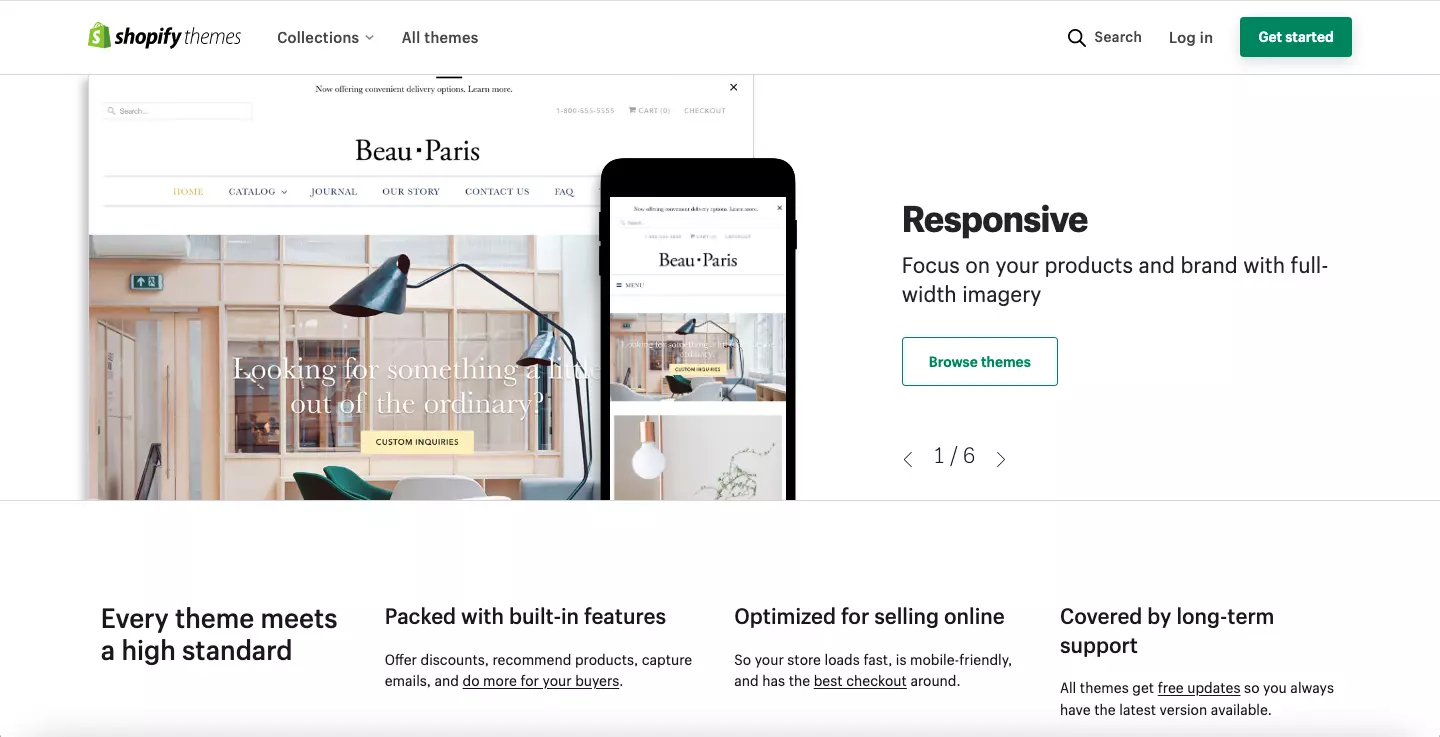
Furthermore, the flexible and creative UI/UX elements are of great value. Vendors can attract customers’ attention to the target promotional sections and leave a lasting impression on your website visitors against other competitors.
For instance, they can display information about best-selling and recommended products via slides and image carousels, as well as customize categories, tags, and searches to boost product discovery.
Similarly, what if you wish to make bespoke changes to the chosen default theme and templates? Shopify’s editor can make it possible to add touches here and there for preference. A few rearrangements in Shopify’s layout, the fonts, and the color scheme, though not as striking as their open-source competitors, will suffice for your business growth.
eBay’s design and theme
By contrast, eBay allows you to use their default layout and change your store profile pictures, and that’s all there is to it. In fact, they do not provide themes and quite lacking in the visual department. You will have to make do with their logo and branding characteristics thereof.
Besides, you need to pay extra mind to the quality of the listing images and the suitability of the listing templates so customers will favor your store over other sellers.
The verdict:
When it comes to design flexibility, eBay cannot hold a candle to Shopify. If store appearance is high on your list of priorities, definitely go with Shopify for its customization possibilities.
Help & support system
Shopify’s support system
All things considered, other sales channels can hardly overcome Shopify at this. It offers multiple support methods for online merchants to choose from, either indirectly or face-to-face.
In particular, the indirect support system includes a help center, community forums, and video tutorials. Shopify even provides support via email and social media so you can easily keep track of the exchanges.
Meanwhile, if you prefer human interaction, support via phone and live chat is available anytime to take care of your queries.
Under their advanced pricing plans, Shopify even assigns you a special agent to deliver specialist support free of charge in case of emergency.
eBay’s support system
Compared to Shopify, eBay does not provide support methods as diverse, and you mainly get access to their Help Center and Community for documentation and fellow sharing, respectively.
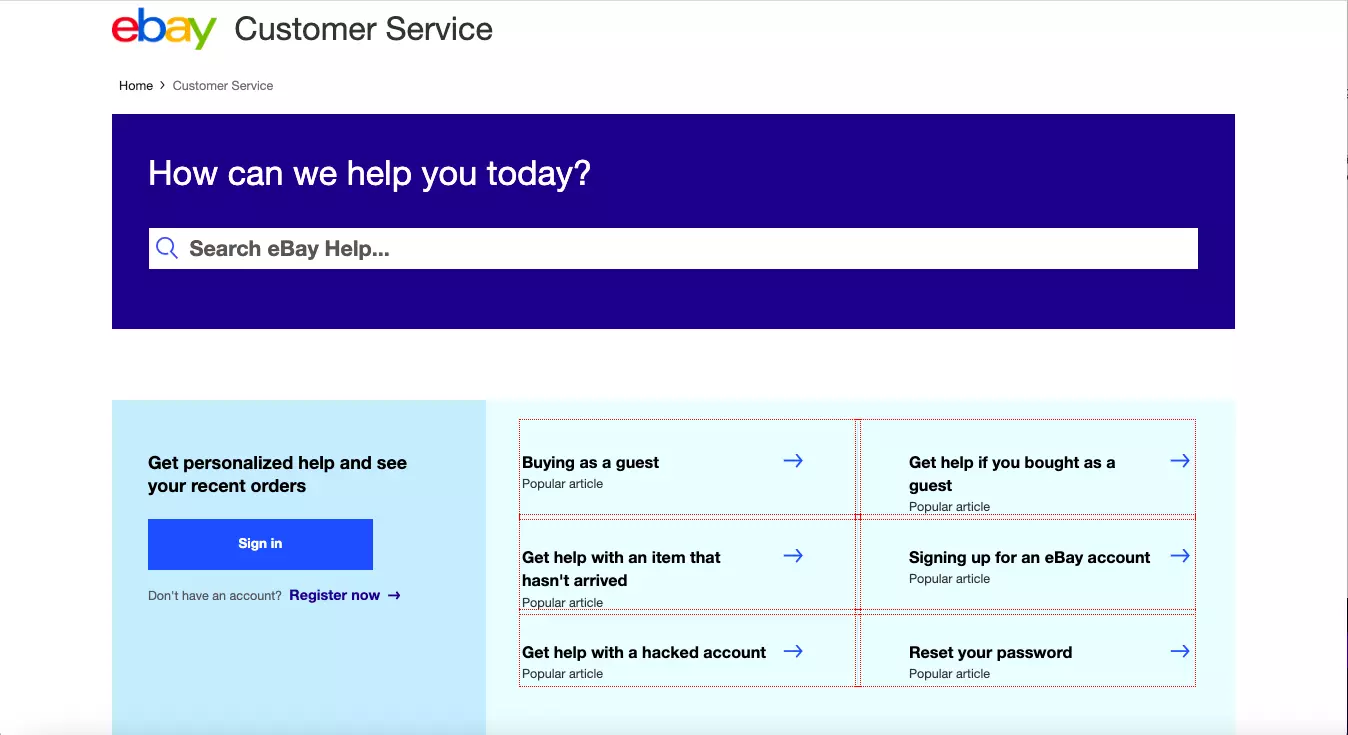
Although quite limited, you can count on chatbot, live chat, and phone calls if you wish to talk directly with their Customer Support team.
Nonetheless, eBay lacks email support, which is possibly a nuisance to their clients. They will find it challenging to dig deep into their requests in detailed conversations with the Customer Support agents.
The verdict:
In conclusion, Shopify beats eBay in the promptness and the variety of support methods available for online sellers.
Shopify vs eBay: The Final Round-up
From our in-depth analysis of Shopify and eBay, here are some highlights we think you may need.
- Selling on Shopify is about you coming to your full roles, from managing listings and inventory to making sure your brand has sales and will be sustainable.
- Meanwhile, eBay helps sellers focus on the selling part. The marketplace also puts its focus on listing promotion and all trading activities that go within the platform.
- From our experts’ viewpoint, if you are an individual seller, especially with secondhand items or rare ones, eBay is your ideal channel. On the other hand, Shopify is great for businesses that need extensive analytics and eCommerce features.
Is selling on these platforms hard? Yes, it certainly is. No matter if you sell on eBay or Shopify, you will be spending time and effort to make sales happen. For Shopify, it’s about driving traffic to your store and enhancing the best customer experience ever. And eBay? Figure out how you will compete with millions of sellers who might be selling the same items as you.
You may want to read: Selling on Amazon vs eBay: Which Is Better [Latest Updates].
Shopify vs eBay: FAQs
You can by all means list and sell your Shopify products on eBay by integrating Shopify with eBay using multi-channel selling tools like litCommerce. It is possible to make the most of each channel’s strengths and enjoy the best of both worlds with litCommerce as your reliable multichannel selling partner, which is all the more reason to connect Shopify to eBay. Relevant aspects covered, you can start your own eCommerce journey with eBay as a beginner. Their ever-present online marketplace nature will get you used to the inner workings of the industry and, particularly, your investments with the lowest risks involved. In fact, against other competitors in the market, Shopify is still the best choice for eCommerce users. They can get online stores up and running quickly with the added advantages of themes, ease of use, support system, and data security for good measure. You can quickly secure success with your Shopify store should you come up with appropriate strategies for your business and marketing activities. With Shopify shipping, you may have access to pre-negotiated discounts of up to 88% from major carriers like USPS, USP, DHL, and Canada Post.
eBay’s shipping rates are quite expensive. For instance, the USPS shipping rate is about 15% to 25% cheaper than one through eBay (with the same carrier).
So, in some cases, shipping through Shopify can be cheaper than eBay.
Shopify vs eBay: Final Comparison
Hopefully, you have grasped the fundamentals of Shopify vs eBay comparison until this point. The best path here is to get familiar with the eCommerce industry via eBay at the beginner stage, then integrate eBay with Shopify to leverage the eCommerce power combined and scale your business performance.
Lastly, LitCommerce gladly accompanies you along this multi-channel selling journey. With this multi-functional tool, you can bulk list products across different sales channels. Besides, it is possible to manage your orders in a centralized location with ease. Additionally, we can handle your special customization requests that are outside the default service scope it offers.
Please do not hesitate to leave us a message if you want to talk with us about your concerns. Also, visit our Retailer Blog to exchange sharings and experiences with other eCommerce enthusiasts.
Happy selling!

